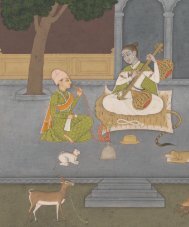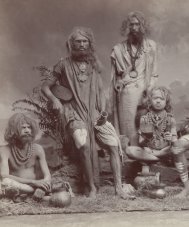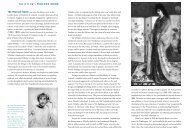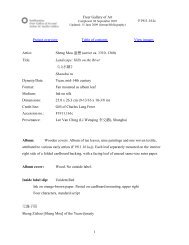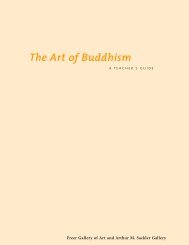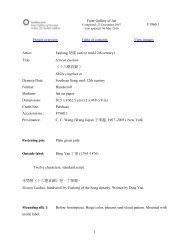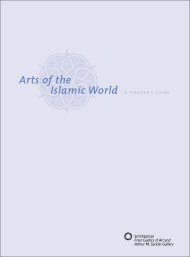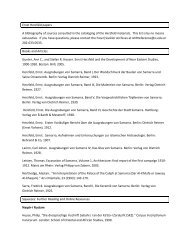Chinese Ceramics in the Late Tang Dynasty - Freer and Sackler ...
Chinese Ceramics in the Late Tang Dynasty - Freer and Sackler ...
Chinese Ceramics in the Late Tang Dynasty - Freer and Sackler ...
You also want an ePaper? Increase the reach of your titles
YUMPU automatically turns print PDFs into web optimized ePapers that Google loves.
<strong>Ch<strong>in</strong>ese</strong> <strong>Ceramics</strong> <strong>in</strong> <strong>the</strong> <strong>Late</strong> <strong>Tang</strong> <strong>Dynasty</strong><br />
Reg<strong>in</strong>a Krahl<br />
The first half of <strong>the</strong> <strong>Tang</strong> dynasty (618–907) was a most prosperous period for <strong>the</strong> <strong>Ch<strong>in</strong>ese</strong><br />
empire. The capital Chang’an (modern Xi’an) <strong>in</strong> Shaanxi prov<strong>in</strong>ce was a magnet for <strong>in</strong>ternational<br />
traders, who brought goods from all over Asia; <strong>the</strong> court <strong>and</strong> <strong>the</strong> country’s aristocracy were<br />
enjoy<strong>in</strong>g a life of luxury. The streets of Chang’an were crowded with foreigners from distant<br />
places—Central Asian, Near Eastern, <strong>and</strong> African—<strong>and</strong> with camel caravans laden with exotic<br />
produce. Courtiers played polo on thoroughbred horses, went on hunts with falconers <strong>and</strong><br />
elegant hounds, <strong>and</strong> congregated over w<strong>in</strong>e while be<strong>in</strong>g enterta<strong>in</strong>ed by foreign orchestras <strong>and</strong><br />
dancers, both male <strong>and</strong> female. Court ladies <strong>in</strong> robes of silk brocade, with jewelry <strong>and</strong> fancy<br />
shoes, spent <strong>the</strong>ir time play<strong>in</strong>g board games on da<strong>in</strong>ty tables <strong>and</strong> talk<strong>in</strong>g to pet parrots, <strong>the</strong>ir<br />
faces made up <strong>and</strong> <strong>the</strong>ir hair dressed <strong>in</strong>to elaborate coiffures.<br />
This is <strong>the</strong> picture of <strong>Tang</strong> court life portrayed <strong>in</strong> colorful tomb pottery, created at great<br />
expense for lavish burials. By <strong>the</strong> seventh century <strong>the</strong> manufacture of sophisticated pottery<br />
replicas of men, beasts, <strong>and</strong> utensils had become a huge <strong>in</strong>dustry <strong>and</strong> <strong>the</strong> most important<br />
use of ceramic material <strong>in</strong> Ch<strong>in</strong>a (apart from tilework). Such ear<strong>the</strong>nware pottery, relatively<br />
easy <strong>and</strong> cheap to produce s<strong>in</strong>ce <strong>the</strong> necessary raw materials were widely available <strong>and</strong> fir<strong>in</strong>g<br />
temperatures relatively low (around 1,000 degrees C), was unfit for everyday use; its coldpa<strong>in</strong>ted<br />
pigments were unstable <strong>and</strong> its lead-bear<strong>in</strong>g glazes poisonous. Yet it was perfect for<br />
creat<strong>in</strong>g a dazzl<strong>in</strong>g display at funeral ceremonies (fig. 35). Stoneware, which <strong>in</strong> Ch<strong>in</strong>a had<br />
already been produced <strong>in</strong> parallel with ear<strong>the</strong>nware for some 2,000 years, was much more<br />
dem<strong>and</strong><strong>in</strong>g to manufacture, required much higher temperatures (more than 1,200 degrees C),<br />
was prone to warp or crack <strong>in</strong> <strong>the</strong> kiln, <strong>and</strong> was considered less appeal<strong>in</strong>g due to its limited <strong>and</strong><br />
subdued color range of olive green, brown, <strong>and</strong> a neutral off-white. It was not <strong>in</strong> great dem<strong>and</strong>.<br />
The rebellion of An Lushan <strong>in</strong> 755, though it was quelled after a few years, put <strong>the</strong> country<br />
<strong>in</strong>to turmoil <strong>and</strong> proved a most sober<strong>in</strong>g event with a last<strong>in</strong>g effect on <strong>the</strong> glory <strong>and</strong> gr<strong>and</strong>eur<br />
of <strong>the</strong> empire. Weakened central authority, a shaken <strong>and</strong> disoriented bureaucracy, <strong>and</strong> actual<br />
physical damage afflicted on <strong>the</strong> countryside triggered a shift <strong>in</strong> values. While imperial lifestyles<br />
<strong>and</strong> burials rema<strong>in</strong>ed lavish, outside <strong>the</strong> court <strong>the</strong> display of riches was no longer a goal <strong>in</strong><br />
itself. Already <strong>in</strong> <strong>the</strong> first half of <strong>the</strong> eighth century repeated imperial edicts had been issued<br />
aga<strong>in</strong>st <strong>in</strong>creas<strong>in</strong>g ostentation at funerals; <strong>the</strong>y bore fruit <strong>in</strong> <strong>the</strong> second half of <strong>the</strong> century, when<br />
<strong>in</strong>terments were stripped of excessive pomp, <strong>and</strong> virtually no more ceramics were produced<br />
specially for burial.<br />
With confidence <strong>in</strong> <strong>the</strong> traditional rul<strong>in</strong>g classes underm<strong>in</strong>ed, new forces ga<strong>in</strong>ed <strong>in</strong>fluence<br />
<strong>in</strong> society, <strong>and</strong> not through such conventional ladders of success as <strong>in</strong>heritance or state<br />
exam<strong>in</strong>ations. The move toward greater sobriety set free a change <strong>in</strong> aspirations, an <strong>in</strong>terest<br />
45
<strong>in</strong> connoisseurship ra<strong>the</strong>r than wealth, <strong>and</strong> a more sophisticated approach to luxury goods<br />
that focused less on <strong>the</strong> obvious values of precious materials than on <strong>in</strong>herent qualities like<br />
workmanship <strong>and</strong> artistry.<br />
A new k<strong>in</strong>d of vessel, made of ceramic, thus arrived on <strong>Ch<strong>in</strong>ese</strong> tables. Some ceramics<br />
developed a dist<strong>in</strong>ct style—still heavily potted but often pure white, with a glossy colorless<br />
glaze that formed thick glassy drops. Even if not quite on par with <strong>the</strong> aristocracy’s preferred<br />
materials <strong>in</strong> <strong>the</strong> prosperous period known as <strong>the</strong> High <strong>Tang</strong>, 1 such as gold <strong>and</strong> silver, mo<strong>the</strong>r-<br />
of-pearl, tortoiseshell, or foreign glass, <strong>the</strong> ware was undeniably attractive (fig. 36).<br />
The full sw<strong>in</strong>g toward an acceptance of ceramics <strong>in</strong> <strong>the</strong> highest places came with <strong>the</strong> new<br />
fashion for tea-dr<strong>in</strong>k<strong>in</strong>g <strong>in</strong> <strong>the</strong> <strong>Tang</strong> dynasty. Reflect<strong>in</strong>g this trend, <strong>in</strong> his well-known manual<br />
on tea, Chaj<strong>in</strong>g (The Classic of Tea), written between 760 <strong>and</strong> 780, <strong>the</strong> poet Lu Yu (730s–circa<br />
804) elevated <strong>the</strong> consumption of tea <strong>in</strong>to a ceremony to be celebrated <strong>in</strong> style. Tea was <strong>the</strong>n<br />
consumed very differently from today. Tea leaves, often shaped <strong>in</strong>to cakes, were ground to<br />
a powder, <strong>in</strong>fused with hot water <strong>in</strong> large bowls, <strong>and</strong> whisked <strong>in</strong>to froth, or else added to a<br />
cauldron of boil<strong>in</strong>g water, stirred, <strong>and</strong> <strong>the</strong>n ladled <strong>in</strong>to bowls. Mixed with salt <strong>and</strong> sometimes<br />
spices, herbs, fruits, <strong>and</strong> o<strong>the</strong>r aromatics, tea often resembled a soup more than a beverage.<br />
Lu Yu lists <strong>and</strong> carefully describes more than twenty accoutrements as required for <strong>the</strong><br />
preparation of tea. Tea bowls were def<strong>in</strong>itely ceramic, <strong>and</strong> here Lu Yu is adamant: it had to<br />
be ei<strong>the</strong>r Yue ware from Zhejiang or X<strong>in</strong>g ware from Hebei; o<strong>the</strong>rs he declared unworthy. 2<br />
By rank<strong>in</strong>g different types of tea bowls <strong>and</strong> pass<strong>in</strong>g judgment on <strong>the</strong>ir quality, beauty, <strong>and</strong><br />
suitability, Lu Yu was probably <strong>the</strong> first to express an aes<strong>the</strong>tic appreciation of ceramics. At <strong>the</strong><br />
same time he propagated <strong>the</strong> names of specific manufactur<strong>in</strong>g centers. <strong>Ceramics</strong> had never<br />
before been associated with kiln names; now <strong>the</strong>se became br<strong>and</strong> names for f<strong>in</strong>e tablewares.<br />
O<strong>the</strong>r items—such as <strong>the</strong> tea bowl st<strong>and</strong>; ewer for hot water; conta<strong>in</strong>er for tea, salt, <strong>and</strong> o<strong>the</strong>r<br />
spices; mortar for gr<strong>in</strong>d<strong>in</strong>g <strong>the</strong> tea; plate for accompany<strong>in</strong>g food; <strong>and</strong> <strong>in</strong>cense burner—could be<br />
46<br />
page 44<br />
Fig. 34 Large lidded<br />
jar. cat. 276.<br />
left<br />
Fig. 35 Sancai (threecolor)<br />
glazed figure<br />
of a camel laden with<br />
goods, shaanxi or<br />
henan prov<strong>in</strong>ce,<br />
tang dynasty, 7th<br />
or early 8th century.<br />
Meiy<strong>in</strong>tang collection.<br />
Fig. 36 White<br />
stoneware bottle,<br />
hebei prov<strong>in</strong>ce, sui<br />
dynasty, late 6th or<br />
early 7th century.<br />
Meiy<strong>in</strong>tang collection.<br />
Fig. 37 Gongxian<br />
fragment of a tea<br />
gr<strong>in</strong>der recovered<br />
from <strong>the</strong> baihe kiln<br />
site, Gongyi county,<br />
henan prov<strong>in</strong>ce.
Fig. 38 Major kiln sites<br />
<strong>in</strong> 9th-century ch<strong>in</strong>a.<br />
of various materials, such as lacquer, wood, or metal, but <strong>the</strong>y, too, could be ceramic. Examples of<br />
all <strong>the</strong>se shapes have been recovered from <strong>the</strong> Belitung wreck, <strong>in</strong>clud<strong>in</strong>g several wheels for tea<br />
gr<strong>in</strong>ders (fig. 37), a type made by various kilns, <strong>in</strong>clud<strong>in</strong>g Gongxian <strong>in</strong> Henan <strong>and</strong> Changsha <strong>in</strong><br />
Hunan. <strong>Ceramics</strong>, of course, also made perfect vessels for w<strong>in</strong>e, <strong>in</strong> Ch<strong>in</strong>a usually a gra<strong>in</strong>-based<br />
fermented or distilled dr<strong>in</strong>k that was stored <strong>in</strong> large covered jars, heated up, <strong>and</strong> poured from<br />
bottles with a narrow open<strong>in</strong>g. Both <strong>the</strong>se procedures of tea <strong>and</strong> w<strong>in</strong>e preparation were similar<br />
to those still kept alive <strong>in</strong> Japan today (fig. 39).<br />
Between <strong>the</strong> mid-eighth <strong>and</strong> late n<strong>in</strong>th centuries, Yue <strong>and</strong> X<strong>in</strong>g ware are repeatedly referred<br />
to <strong>in</strong> literature, particularly poetry, as symbols of beauty, elegance, taste, novelty, <strong>and</strong> wealth.<br />
Neiqiu (one of <strong>the</strong> X<strong>in</strong>g kilns) w<strong>in</strong>e bottles are thus mentioned, toge<strong>the</strong>r with jade cups, <strong>in</strong><br />
connection with different w<strong>in</strong>es. 3 White porcela<strong>in</strong> bottles from Neiqiu <strong>and</strong> Duan <strong>in</strong>kstones—<br />
equally precious—are said to have been used by everybody, <strong>the</strong> noble as well as <strong>the</strong> lowly, a<br />
remark that should probably be taken as a metaphor for <strong>the</strong> affluence <strong>and</strong> prosperity of <strong>the</strong> times<br />
ra<strong>the</strong>r than as a literal observation. 4 The likeness of Yue ware to jade <strong>and</strong> X<strong>in</strong>g to silver, noted<br />
by Lu Yu, was taken up by various o<strong>the</strong>r writers. It related not only to <strong>the</strong> colour <strong>and</strong> tactility<br />
of <strong>the</strong>se ceramics, but also to <strong>the</strong> resonance of <strong>the</strong>ir high-fired stoneware material. Dur<strong>in</strong>g <strong>the</strong><br />
Wuzong reign (840–46) a certa<strong>in</strong> Guo Daoyuan is said to have used twelve Yue <strong>and</strong> X<strong>in</strong>g ware<br />
ch<strong>in</strong>ese ceramics <strong>in</strong> <strong>the</strong> <strong>Late</strong> tang dynasty | Reg<strong>in</strong>a Krahl<br />
47
48<br />
above<br />
Fig. 39 Preparation<br />
of tea <strong>and</strong> w<strong>in</strong>e, mural<br />
from a Liao dynasty<br />
(907–1125) tomb of<br />
1093 show<strong>in</strong>g <strong>the</strong><br />
typical tea utensils<br />
of <strong>the</strong> tang still <strong>in</strong><br />
use, but w<strong>in</strong>e bottles<br />
replaced by ewers.
owls filled with vary<strong>in</strong>g amounts of water to play a musical scale—just like performances still<br />
done with glasses today. Their tone is said to have surpassed that of chimes made of jade. 5<br />
Yue <strong>and</strong> X<strong>in</strong>g wares were even compared to <strong>the</strong> tw<strong>in</strong> souls hun <strong>and</strong> po, a Daoist concept of<br />
<strong>in</strong>teract<strong>in</strong>g opposites that form a whole, which probably reflects on <strong>the</strong>ir significance as <strong>the</strong> major<br />
ceramic representatives of <strong>the</strong> south <strong>and</strong> <strong>the</strong> north, respectively. 6 By <strong>the</strong> late n<strong>in</strong>th century, when<br />
<strong>the</strong> imperial household <strong>in</strong>cluded fourteen vessels of Yue ware <strong>in</strong> its magnificent gift of conta<strong>in</strong>ers<br />
of food, tea, <strong>in</strong>cense, <strong>and</strong> relics of <strong>the</strong> Buddha to <strong>the</strong> Famensi, a temple near Chang’an, <strong>the</strong>se<br />
ceramics had reached a level that was hard to surpass. Yet by that time, not only was <strong>the</strong> emperor’s<br />
veneration of <strong>the</strong> temple's Buddha bone severely criticized by <strong>the</strong> educated elite, but <strong>the</strong> use<br />
of <strong>the</strong>se f<strong>in</strong>e ceramics was also denounced, as <strong>the</strong>y had become a prerogative of <strong>the</strong> rich. One<br />
writer mourned <strong>in</strong> his verses <strong>the</strong> excessive quantity of trees used to fire <strong>the</strong>se wares, poetically<br />
describ<strong>in</strong>g <strong>the</strong> deforestation as “Robb<strong>in</strong>g a thous<strong>and</strong> mounta<strong>in</strong> peaks of <strong>the</strong>ir k<strong>in</strong>gfisher-blue.”<br />
The erstwhile objects of admiration became symbols of <strong>the</strong> decadence of <strong>the</strong> times. 7<br />
Outside <strong>in</strong>terest <strong>in</strong> <strong>Ch<strong>in</strong>ese</strong> ceramics rose through <strong>in</strong>creased contact with <strong>the</strong>se miraculous<br />
novelties that were hard as stone <strong>and</strong> sparkl<strong>in</strong>g like metal, did not easily crack, crackle, or chip—<br />
like ceramics usually did—<strong>and</strong> rema<strong>in</strong>ed dense, immaculately clean, <strong>and</strong> hygienic, even after<br />
prolonged use. A proper mystique developed around <strong>the</strong>m through seafarers’ tales, especially<br />
where <strong>the</strong> actual objects had never been seen. The Arab merchant Sulayman recorded <strong>in</strong> 851,<br />
probably after hav<strong>in</strong>g seen or heard of some translucent X<strong>in</strong>g wares, “The <strong>Ch<strong>in</strong>ese</strong> have a f<strong>in</strong>e<br />
clay of which <strong>the</strong>y fashion dr<strong>in</strong>k<strong>in</strong>g vessels that are as delicate as glass <strong>and</strong> through which one<br />
can see <strong>the</strong> water, despite that <strong>the</strong>y are of clay <strong>and</strong> not of glass.” 8 Of course, <strong>the</strong> majority of <strong>Tang</strong><br />
stonewares, <strong>in</strong>clud<strong>in</strong>g all those on <strong>the</strong> Belitung wreck, was not of this magic quality.<br />
With <strong>the</strong> grow<strong>in</strong>g dem<strong>and</strong> at home <strong>and</strong> abroad, new kilns sprang up <strong>in</strong> many prov<strong>in</strong>ces,<br />
<strong>and</strong> those that had made low-fired tomb ceramics before now changed to mak<strong>in</strong>g high-fired<br />
tablewares <strong>and</strong> o<strong>the</strong>r utilitarian ceramics. In Ch<strong>in</strong>a, a taste for <strong>the</strong> unmannered beauty of<br />
monochrome ceramics, which focused on <strong>the</strong> vessel’s material <strong>and</strong> shape, crystallized at this<br />
time <strong>and</strong> reached its full maturity <strong>in</strong> <strong>the</strong> Song dynasty (960–1279), when variety was at its<br />
peak. Abroad, a delight <strong>in</strong> color <strong>and</strong> ornament called for a different approach. Workshops less<br />
highly regarded <strong>in</strong>l<strong>and</strong>, such as Gongxian, which made lesser white stonewares, <strong>and</strong> Changsha,<br />
which produced a poorer version of green stonewares, responded by add<strong>in</strong>g colored decoration<br />
to <strong>the</strong>ir wares. The Gongxian kilns, Ch<strong>in</strong>a’s erstwhile tomb furniture suppliers, adapted some<br />
of <strong>the</strong>ir former color<strong>in</strong>g agents, such as copper <strong>and</strong> cobalt, to <strong>the</strong>ir new wares to create bright<br />
green splashes <strong>and</strong> blue designs. The Changsha kilns used iron <strong>and</strong> copper for brown, green,<br />
<strong>and</strong> occasionally red designs pa<strong>in</strong>ted under <strong>the</strong> glaze, <strong>and</strong> for monochrome glazes. The cargo<br />
<strong>in</strong>cluded examples with a strik<strong>in</strong>g <strong>and</strong> exceed<strong>in</strong>gly rare monochrome copper-red glaze, albeit<br />
very degraded. 9 Located far from Ch<strong>in</strong>a’s seats of power, centers of commerce, <strong>and</strong> similar kiln<br />
centers, <strong>the</strong> Changsha kilns (fig. 38) are a case apart <strong>in</strong> <strong>the</strong> history of <strong>Tang</strong> ceramics, s<strong>in</strong>ce <strong>the</strong>y<br />
operated quite <strong>in</strong>dependently, creat<strong>in</strong>g <strong>the</strong>ir own techniques, shapes, <strong>and</strong> designs.<br />
These more colorful ceramics found an eager clientele abroad. <strong>Ch<strong>in</strong>ese</strong> ceramics had<br />
reached western Asia by <strong>the</strong> fifth century, <strong>and</strong> occasionally even earlier, 10 but <strong>the</strong> onerous<br />
transport across <strong>the</strong> desert via camel caravans did not make ceramics trade goods of choice, <strong>and</strong><br />
until <strong>the</strong> mid-<strong>Tang</strong> dynasty <strong>the</strong>y rema<strong>in</strong>ed rare abroad. Proper boat traffic with opportunities for<br />
mass transport from <strong>the</strong> sou<strong>the</strong>astern ports of Ch<strong>in</strong>a to trad<strong>in</strong>g posts all across Asia <strong>and</strong> as far<br />
as Africa developed from <strong>the</strong> late eighth century onward, <strong>and</strong> <strong>the</strong> trade of <strong>Ch<strong>in</strong>ese</strong> ceramics to<br />
<strong>the</strong> Near East seems to have been well established by about 800. 11 Circumstances improved after<br />
829, when an edict granted imperial protection to foreign merchants operat<strong>in</strong>g <strong>in</strong> Guangdong,<br />
Fujian, <strong>and</strong> Yangzhou. 12 Yet this did not last long; trade was brutally brought to a halt with <strong>the</strong><br />
sack of Guangzhou by <strong>the</strong> rebel leader Huang Chao, who <strong>in</strong> 879 devastated <strong>the</strong> port <strong>and</strong> killed<br />
vast numbers of its foreign merchants; accord<strong>in</strong>g to some accounts <strong>the</strong>y comprised more than<br />
half of <strong>the</strong> city’s population. 13 Thereafter, it was apparently not until <strong>the</strong> tenth century that<br />
ch<strong>in</strong>ese ceramics <strong>in</strong> <strong>the</strong> <strong>Late</strong> tang dynasty | Reg<strong>in</strong>a Krahl<br />
49
50<br />
Fig. 40 this green-<br />
splashed cup from<br />
henan <strong>and</strong> a white cup<br />
from hebei <strong>in</strong> <strong>the</strong> north<br />
share a central Asian<br />
metal form with a gold<br />
cup, probably from<br />
Jiangsu <strong>in</strong> <strong>the</strong> south.<br />
cats. 224, 272, 299.
Fig. 41 <strong>the</strong>se X<strong>in</strong>g,<br />
yue, <strong>and</strong> Guangdong<br />
bowls share a stylistic<br />
unity despite <strong>the</strong><br />
distance between<br />
<strong>the</strong>ir respective kilns.<br />
cats. 266, 238, 259.<br />
ch<strong>in</strong>ese ceramics <strong>in</strong> <strong>the</strong> <strong>Late</strong> tang dynasty | Reg<strong>in</strong>a Krahl<br />
51
maritime trade recovered. The voyage of <strong>the</strong> Belitung ship may have taken place <strong>in</strong> this period of<br />
<strong>the</strong> highest trade activity, circa 829 to 879.<br />
The <strong>Tang</strong> authorities, who closely monitored all <strong>in</strong>ternational trade, do not seem to have<br />
considered ceramics valuable or rare enough to restrict <strong>the</strong>ir export. Although at that time<br />
Ch<strong>in</strong>a no longer held a monopoly on <strong>the</strong> production of silk, <strong>the</strong> export or sale to foreigners of<br />
f<strong>in</strong>e silk fabrics (toge<strong>the</strong>r with that of pearls, gold, <strong>and</strong> o<strong>the</strong>r items of value) were forbidden<br />
by an edict of 714. Stoneware ceramics, on <strong>the</strong> o<strong>the</strong>r h<strong>and</strong>, where Ch<strong>in</strong>a reta<strong>in</strong>ed an absolute<br />
monopoly, never seem to have been affected by any trade restrictions. 14 Perhaps <strong>the</strong>se would<br />
have been too difficult to survey given <strong>the</strong> wide distribution of stoneware manufactur<strong>in</strong>g<br />
throughout Ch<strong>in</strong>a.<br />
Trade <strong>in</strong> ceramics <strong>the</strong>refore could be ei<strong>the</strong>r a private transaction or an affair of state. Much<br />
exchange of goods with foreigners was conducted directly at <strong>the</strong> ports, where <strong>Ch<strong>in</strong>ese</strong> ceramics<br />
were for sale or boats could be filled with <strong>the</strong> help of local officials. Alternatively, trade could<br />
be conducted via national channels as a k<strong>in</strong>d of barter, where an arriv<strong>in</strong>g “embassy,” which<br />
could consist of foreign envoys or simply merchants, formally offered “tribute” to <strong>the</strong> court <strong>and</strong><br />
received “gifts” <strong>in</strong> return. Foreigners, who had no direct access to workshops located <strong>in</strong>l<strong>and</strong>,<br />
could specify what k<strong>in</strong>d of wares <strong>the</strong>y wished to receive. An official <strong>in</strong>volvement of <strong>the</strong> court<br />
with <strong>the</strong> cargo of <strong>the</strong> Belitung ship might expla<strong>in</strong> its splendid <strong>and</strong> surpris<strong>in</strong>g load of gold <strong>and</strong><br />
silver objects, <strong>the</strong> valuable component of f<strong>in</strong>e Yue <strong>and</strong> X<strong>in</strong>g wares, as well as <strong>the</strong> <strong>in</strong>clusion of two<br />
ceramic items with <strong>in</strong>scriptions suggest<strong>in</strong>g a court connection.<br />
A bright green-glazed bowl bears <strong>the</strong> character y<strong>in</strong>g (fig. 43), which more typically is found<br />
on white X<strong>in</strong>g wares (fig. 44) of <strong>the</strong> latter half of <strong>the</strong> n<strong>in</strong>th <strong>and</strong> tenth centuries. Y<strong>in</strong>g, mean<strong>in</strong>g<br />
“surplus,” is believed to be an abbreviation of da y<strong>in</strong>g ku or bai bao da y<strong>in</strong>g ku, “Great Surplus<br />
Storehouse [of a Hundred Treasures],” an official <strong>Tang</strong> treasury conta<strong>in</strong><strong>in</strong>g items used at<br />
court. 15 A dish with green splashes on a white ground is <strong>in</strong>scribed j<strong>in</strong>feng, or “respectfully<br />
offered as tribute” (fig. 45). This <strong>in</strong>scription is better known from D<strong>in</strong>g wares (fig. 46), where it<br />
was engraved after fir<strong>in</strong>g. 16 The two pieces from <strong>the</strong> Belitung cargo most likely come from <strong>the</strong><br />
Gongxian kilns of Henan, which are known to have offered ceramics as tribute to <strong>the</strong> court. It is<br />
<strong>the</strong>refore possible that <strong>the</strong>y orig<strong>in</strong>ally were offered by <strong>the</strong> kilns to <strong>the</strong> imperial house, <strong>and</strong> <strong>the</strong>n<br />
awarded by <strong>the</strong> court to an “embassy” that arrived with <strong>the</strong> ship.<br />
The <strong>in</strong>scription of such characters was by no means monitored or restricted, however, <strong>and</strong><br />
<strong>the</strong> mean<strong>in</strong>g cannot necessarily be taken literally. Enhanc<strong>in</strong>g epi<strong>the</strong>ts such as <strong>the</strong>se, which were<br />
mean<strong>in</strong>gful <strong>in</strong> connection with ano<strong>the</strong>r ware, were often copied by lesser workshops, especially<br />
if pieces were meant to be sold on <strong>the</strong> open market. The <strong>in</strong>scription guan (mean<strong>in</strong>g “official”),<br />
for example, <strong>in</strong>scribed on D<strong>in</strong>g wares from around <strong>the</strong> same time, not only has been discovered<br />
<strong>in</strong> excavations <strong>in</strong> a <strong>Tang</strong> context but also at Liao (907–1125), Five Dynasties (907–60), <strong>and</strong><br />
Nor<strong>the</strong>rn Song (960–1127) sites, which <strong>in</strong>cluded tombs <strong>and</strong> temples, thus rais<strong>in</strong>g serious<br />
questions about <strong>the</strong> mean<strong>in</strong>g of “official.” 17 The character guan also was engraved on pieces from<br />
lesser kilns, where any official connection seems even more doubtful. The precise significance<br />
of <strong>the</strong>se <strong>in</strong>scriptions is <strong>the</strong>refore uncerta<strong>in</strong>.<br />
On <strong>the</strong> o<strong>the</strong>r h<strong>and</strong>, <strong>the</strong> vast majority of vessels on this boat—some 57,000 ceramics from <strong>the</strong><br />
Changsha kilns, professionally packed <strong>in</strong> Guangdong storage jars (see p. 55)—must have exceeded<br />
by far <strong>the</strong> capacities of such tribute trade; it also seems unlikely that such quantities would have<br />
been stocked at port await<strong>in</strong>g a buyer. Here, a more direct connection from merchants to <strong>the</strong> kilns<br />
is more probable. The remarkable stylistic uniformity displayed by <strong>the</strong> Changsha wares might<br />
also po<strong>in</strong>t to a s<strong>in</strong>gle delivery. Although foreigners usually did not place orders directly from <strong>the</strong><br />
kilns, <strong>the</strong> representation of a curly-haired foreigner on one of <strong>the</strong> Changsha bowls attests to <strong>the</strong>ir<br />
presence <strong>in</strong> this <strong>in</strong>l<strong>and</strong> region, away from traditional trade routes.<br />
Unfortunately, <strong>the</strong> greatest portion of <strong>the</strong>se Changsha wares, <strong>the</strong> bowls <strong>and</strong> ewers, were<br />
made similarly throughout <strong>the</strong> n<strong>in</strong>th century, <strong>and</strong> products of different decades do not seem to<br />
52
ight<br />
Fig. 42 changsha<br />
bowl with head of<br />
central or West Asian<br />
man. cat. 166.<br />
left<br />
Fig. 43 Greenglazed<br />
bowl <strong>and</strong><br />
detail of its base<br />
<strong>in</strong>cised with <strong>the</strong><br />
character y<strong>in</strong>g<br />
(“surplus”). cat. 230.<br />
Fig. 44 X<strong>in</strong>g bowl<br />
<strong>in</strong>cised with <strong>the</strong><br />
character y<strong>in</strong>g<br />
(“surplus”).<br />
Fig. 45 detail of a<br />
green-splashed dish,<br />
<strong>in</strong>cised with <strong>the</strong><br />
characters j<strong>in</strong>feng<br />
(“for tribute”). cat. 231.<br />
Fig. 46 D<strong>in</strong>g bowl<br />
<strong>in</strong>cised after fir<strong>in</strong>g with<br />
<strong>the</strong> characters j<strong>in</strong>feng.<br />
manifest clear dist<strong>in</strong>guish<strong>in</strong>g features. Although one Changsha bowl bears a roughly <strong>in</strong>cised<br />
date on <strong>the</strong> outside (fig. 12), its reign date is so sketchily engraved that it is identified as <strong>the</strong> Baoli<br />
period (825–26) more through negative than positive evidence. The o<strong>the</strong>r types of ceramics,<br />
which are equally characterized by great stylistic unity, display a more short-lived style. Yue<br />
vessels echo shapes <strong>in</strong> gold (e.g., four-lobed square dishes; four-lobed round dishes; quatrefoiloval<br />
bowls); Yue wares share many forms with X<strong>in</strong>g (e.g., conical <strong>and</strong> rounded bowls with bi-disc<br />
foot, w<strong>in</strong>e bottles); Hebei white <strong>and</strong> Henan green-splashed wares have a foreign cup shape <strong>in</strong><br />
common with <strong>the</strong> gold (fig. 40); Yue, Guangdong, X<strong>in</strong>g, D<strong>in</strong>g, <strong>and</strong> Gongxian wares made use of<br />
<strong>the</strong> same dist<strong>in</strong>ctive foot <strong>in</strong> form of an ancient jade disc (bi), <strong>and</strong> so on (fig. 41). The Yue wares<br />
offer <strong>the</strong> most useful comparative material for dat<strong>in</strong>g this cargo, which po<strong>in</strong>ts to <strong>the</strong> 840s. 18<br />
Shapes found among gold, silver, <strong>and</strong> Yue wares also have been discovered replicated <strong>in</strong> stone<br />
<strong>in</strong> a tomb of 845. 19 This consistent style did not last long, as shapes became more dist<strong>in</strong>ct <strong>in</strong><br />
proportion, four-lobed forms were superseded by five-lobed ones, ceramic quality was fur<strong>the</strong>r<br />
ref<strong>in</strong>ed, styles like <strong>the</strong> green-splashed <strong>and</strong> blue-decorated wares were discont<strong>in</strong>ued, <strong>and</strong> kiln<br />
centers such as Gongxian decl<strong>in</strong>ed while o<strong>the</strong>rs, such as D<strong>in</strong>g <strong>in</strong> Hebei, rose to prom<strong>in</strong>ence.<br />
The amaz<strong>in</strong>g quantity <strong>and</strong> great variety of this f<strong>in</strong>d, which <strong>in</strong>cludes <strong>the</strong> f<strong>in</strong>est wares from<br />
<strong>the</strong> major kilns, offers a unique cross-section of <strong>the</strong> ceramic production <strong>in</strong> <strong>the</strong> late <strong>Tang</strong>. 20 It<br />
illustrates a poignant moment <strong>in</strong> time, on <strong>the</strong> very threshold of <strong>the</strong> potters’ most glorious period,<br />
<strong>and</strong> thus provides an important marker <strong>in</strong> <strong>the</strong> history of <strong>Ch<strong>in</strong>ese</strong> ceramics.<br />
ch<strong>in</strong>ese ceramics <strong>in</strong> <strong>the</strong> <strong>Late</strong> tang dynasty | Reg<strong>in</strong>a Krahl<br />
53
SHIPWRECKED<br />
TANG TREASURES AND MoNSooN WINDS<br />
How to order<br />
Cloth edition<br />
328 pages | 9”x 12” | $65.00 US / $74.00 Can<br />
220 color <strong>and</strong> 235 B&W illustrations<br />
ISBN 978-1-58834-305-5<br />
Distributed worldwide by Smithsonian Books via R<strong>and</strong>om House<br />
Available from Amazon.com, Barnes & Noble.com, <strong>and</strong> f<strong>in</strong>e bookstores everywhere.<br />
Paperback edition<br />
328 pages | 9”x 12” | $40.00 US/$52.00 S<strong>in</strong>g<br />
220 color <strong>and</strong> 235 B&W illustrations<br />
ISBN 978-0-934686-18-1<br />
Available <strong>in</strong> S<strong>in</strong>gapore from:<br />
ArtScience Museum, Mar<strong>in</strong>a Bay S<strong>and</strong>s<br />
Asian Civilisations Museum <strong>and</strong> o<strong>the</strong>r National Heritage Board museum shops:<br />
www.museumshop.com.sg<br />
About tHis book<br />
Twelve centuries ago, a merchant ship—an Arab dhow—foundered on a reef just off <strong>the</strong> coast of Belitung,<br />
a small isl<strong>and</strong> <strong>in</strong> <strong>the</strong> Java Sea. The cargo was a remarkable assemblage of lead <strong>in</strong>gots, bronze mirrors,<br />
spice-filled jars, <strong>in</strong>tricately worked vessels of silver <strong>and</strong> gold, <strong>and</strong> more than 60,000 glazed bowls, ewers,<br />
<strong>and</strong> o<strong>the</strong>r ceramics. The ship rema<strong>in</strong>ed buried at sea for more than a millennium, its contents protected<br />
from erosion by <strong>the</strong>ir pack<strong>in</strong>g <strong>and</strong> <strong>the</strong> conditions of <strong>the</strong> silty sea floor. Shipwrecked: <strong>Tang</strong> Treasures <strong>and</strong><br />
Monsoon W<strong>in</strong>ds explores <strong>the</strong> story of both <strong>the</strong> sailors <strong>and</strong> <strong>the</strong> ship’s precious cargo through more than<br />
400 gorgeous photographs <strong>and</strong> essays by <strong>in</strong>ternational experts <strong>in</strong> Arab ship-build<strong>in</strong>g methods, pan-Asian<br />
maritime trade, ceramics, precious metalwork, <strong>and</strong> more.<br />
Edited by<br />
Reg<strong>in</strong>a Krahl, John Guy, J. Keith Wilson, <strong>and</strong> Julian Raby<br />
With contributions from<br />
Alison Effeny | Michael Flecker | John Guy | Jessica Hallett | Hsieh M<strong>in</strong>g-liang | Reg<strong>in</strong>a Krahl<br />
Li Baop<strong>in</strong>g with Chen Yuh-shiow <strong>and</strong> Nigel Wood | Liu Yang | François Louis | Qi Dongfang<br />
Tom Vosmer | Wang Gungwu | J. Keith Wilson<br />
Published by<br />
Arthur M. <strong>Sackler</strong> Gallery, Smithsonian Institution, Wash<strong>in</strong>gton, DC<br />
National Heritage Board, S<strong>in</strong>gapore | S<strong>in</strong>gapore Tourism Board



